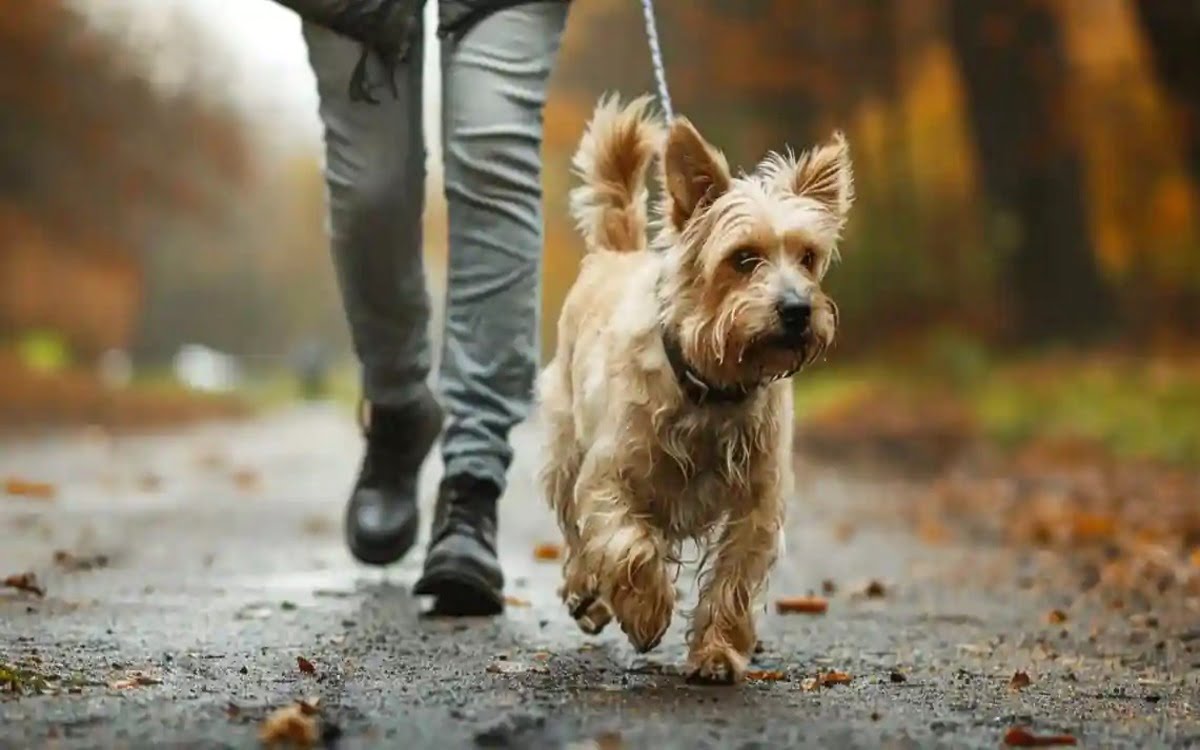Have you ever noticed the transformation in your pup after a good walk? Their tails wag with unrestrained joy, their eyes sparkle with curiosity, and their entire demeanor exudes a sense of calm contentment. That’s the magic of dog walking!
Think of dog walking as more than just a stroll around the block. It’s a symphony of positive changes for your dog’s well-being. Regular walks strengthen their muscles and bones, boost their cardiovascular health, and even aid digestion. But the benefits go far beyond the physical
Imagine your dog as a furry explorer, their senses ignited by the sights, sounds, and smells of the world around them. Walks provide essential mental stimulation, keeping boredom and destructive behaviors at bay. Plus, the shared experience of exploring together strengthens the bond between you and your canine companion.
Did you know that consistent walks can even unlock your dog’s full potential? The focus and discipline practiced during walks can translate beautifully into training sessions, making it easier to teach them new commands and desired behaviors.

The Science Behind the Walk
Alright, let’s get down to the nitty-gritty! Science provides fascinating insights into how dog walking positively impacts our canine companions.
- A Symphony of Systems: Imagine your dog’s body as a complex orchestra, with each system playing a vital role. Regular walks act like a conductor, harmonizing these systems for optimal health.
- Cardiovascular Boost: Just like humans, dogs benefit from increased heart rate and blood flow during walks. This strengthens their heart muscle, improves lung function, and keeps their cardiovascular system in tip-top shape.
- Musculoskeletal Marvels: Walks are fantastic for building and maintaining strong muscles and bones. The movement strengthens your dog’s core, legs, and overall physique, promoting better balance, coordination, and flexibility.
- Digestive Delight: Regular walks get your dog’s digestive system moving, aiding in proper food absorption and waste elimination. This can help prevent constipation and other digestive issues.
Brain Boost: Dog walking isn’t just about physical exercise; it’s a mental workout too!
- Memory Maze: The act of sniffing new environments and encountering novel stimuli during walks can help improve your dog’s memory and cognitive function.
- Reduced Stress Hormones: Studies have shown that walks can lower stress hormone levels in dogs. This translates to a calmer, more relaxed pup, and a happier household for everyone.
- Enhanced Problem-Solving Skills: Exploring new environments encourages dogs to think and problem-solve. Whether it’s navigating obstacles or figuring out the best route to that enticing sniff spot, walks stimulate their brains and keep them sharp.
Happy Hormones: Here’s the cherry on top! Walking triggers the release of “happy hormones” like dopamine and serotonin in both dogs and their owners. These feel-good chemicals contribute to a sense of well-being, reduced anxiety, and a strengthened bond between you and your furry friend.
Benefits of Dog Walking on Different Body Systems
Body System Benefit
- Cardiovascular Improved heart health, better lung function
- Musculoskeletal Stronger muscles and bones, improved balance and coordination
- Digestive Aided food absorption, proper waste elimination
- Brain Enhanced memory, reduced stress hormones, improved problem-solving skills
Getting Equipped for Adventure
Now that you’re brimming with enthusiasm about the magic of dog walking, let’s get you prepped for those pawsome adventures with your furry friend!
Choosing Your Weapon (Leash): Forget boring old leashes! There’s a whole arsenal of leash options available, each with its own advantages:
- Standard Leash: The classic go-to for everyday walks. Choose a comfortable length that allows your dog some freedom to explore while maintaining control.
- Retractable Leash: Offers flexibility and freedom for your dog to roam, but requires responsible handling to avoid tangles or sudden jerks.
- Double Leash: Perfect for walking two dogs simultaneously. Ensure proper training for both pups before attempting this option.
- Slip Lead: Great for training purposes, offering gentle control without a collar. However, it requires a confident handler and a dog with good leash manners.
Consider your dog’s breed, size, temperament, and training level when selecting the perfect leash.
Harnessing Comfort and Control: A well-fitting harness is essential for a comfortable and enjoyable walk for both you and your dog. Here’s what to look for:
- Proper Fit: The harness shouldn’t restrict movement or rub against your dog’s skin. Ensure you can comfortably fit two fingers under the straps.
- Body Type: Different harnesses cater to various body types. Opt for a front-clip harness for dogs who tend to pull, or a back-clip harness for more relaxed walkers.
- Durability: Choose a harness made from high-quality, weather-resistant material that can withstand daily wear and tear.
Beyond the Essentials: Move beyond the leash, collar, and poop bags! Here are some additional items to consider for a successful walk:
- Reflective Vest: Enhance visibility during evening walks, keeping your dog safe.
- Portable Water Dispenser: Keep your pup hydrated on those long walks, especially during hot weather.
- Interactive Walking Toys: Engage your dog’s mind and prevent boredom with a puzzle feeder or a ball launcher.
- Poop Scoop with Extendable Handle: Maintain a hygienic and comfortable experience for everyone involved!
Safety First: Walks are a fantastic bonding experience, but safety should always be a priority. Here are some must-have safety items:
- Identification Tags: Ensure your dog’s collar has updated ID tags with your contact information in case they ever get lost.
- First-Aid Kit: Be prepared for minor scrapes or injuries with a pet-specific first-aid kit.
Training for a Tail-Wagging Time
Imagine walks where your dog walks happily beside you instead of pulling at the leash, barking at every squirrel, or lunging at other dogs. That dream can become a reality with effective leash training!
The Leash Dance: Leash training isn’t about dominance; it’s about establishing clear communication and building a positive association with walks. Here’s a breakdown of the key steps:
- Gear Up: Before you embark on your training journey, ensure you have the right equipment. A comfortable harness and a standard leash (not retractable) are ideal for leash training.
- Start Indoors: Begin training in a calm, distraction-free environment like your living room. Reward your dog with high-value treats (like bits of cooked chicken or cheese) for simply wearing their harness and leash.
- Lure and Reward: Hold a treat near your dog’s nose and slowly walk forward. When they walk beside you with a loose leash, reward them with the treat and praise. Repeat this process until your dog understands the concept of walking calmly next to you.
- Gradually Increase Difficulty: Once your dog has mastered the basics indoors, move your training outdoors to a low-distraction area like your backyard. Gradually introduce more distractions as their leash manners improve.
- Patience is Key: Leash training takes time and patience. Don’t get discouraged if your dog doesn’t get it right away. Be consistent with your training sessions, use positive reinforcement, and celebrate even small victories.
Beyond the Basics: Once your dog has mastered walking politely on a leash, you can move on to more advanced skills:
- “Heel“: Teach your dog to walk beside you on your left side, focusing their attention on you.
- “Leave It“: Train your dog to resist the temptation to pick up objects or chase after distractions during walks.
- “Come“: Ensure your dog reliably returns to you when called, even amidst distractions on walks.
Practicing these commands during walks not only refines your dog’s obedience but also strengthens your bond through positive reinforcement.
Decoding Your Dog: Dogs communicate through body language. Learn to recognize your dog’s cues during walks:
- Sniffing: Allow your dog time to sniff and explore their surroundings. Sniffing is enriching and mentally stimulating for them.
- Pulling: This can indicate excitement or frustration. Redirect your dog’s attention back to you with a treat or a toy.
- Barking: Understand the context – is your dog barking at another dog, a person, or something else? Respond calmly and appropriately depending on the situation.
Troubleshooting Common Challenges: Here are solutions to common leash training hurdles:
- Leash Reactivity: If your dog lunges or barks excessively at other dogs, consult a professional trainer to develop a desensitization plan.
- Distraction: Start training in low-distraction areas and gradually introduce more distractions as your dog’s focus improves.
The Power of Play: Walks shouldn’t just be about getting from point A to point B. Make them fun and engaging for your dog! Incorporate playtime during walks with fetch balls, frisbees, or interactive toys.
Creating Unforgettable Walks
Now that you’ve mastered the essential equipment and training techniques, let’s unlock the magic of crafting unforgettable walks for you and your dog!
Sensory Safari: Walks shouldn’t be monotonous treks around the block. Transform them into exciting sensory adventures for your dog. Explore parks, forests, and trails with varied terrain and smells. Allow your dog to sniff and explore different sights and scents – it’s enriching and mentally stimulating for them.

Social Butterfly: (Note: Only applicable for well-socialized dogs) Does your dog enjoy interacting with other furry friends? If so, consider incorporating safe opportunities for dog socialization during walks. Look for designated dog parks or group walks with friendly dogs to fulfill your pup’s social needs.
Walk This Way: Kick things up a notch with “themed walks” tailored to your dog’s interests! Here are some ideas:
- Sniffing Walks: For scent hounds who love to explore with their noses, dedicate walks to areas rich in interesting smells, like parks with plenty of foliage and trails.
- Water Walks: Breeds who adore water, like Labradors or Golden Retrievers, will relish walks that incorporate water features like lakes, streams, or even a friendly splash pad (with proper permission, of course!).
- Urban Adventures: Expose your curious pup to the sights and sounds of the city with walks through bustling streets, parks with people-watching opportunities, or dog-friendly cafes with outdoor seating.
Seasonal Strolls: Adapt your walks to the seasons to ensure a safe and enjoyable experience for everyone. Here are some tips:
- Summer: Stay hydrated! Carry a portable water dispenser and offer your dog frequent water breaks, especially on hot days. Consider walks during cooler morning or evening hours.
- Winter: Protect your dog’s paws from harsh elements with booties designed for winter walks. Limit walks on icy or snow-covered surfaces to avoid slips and falls.
- Spring & Fall: These seasons offer pleasant walking conditions. Embrace the beauty of blooming flowers in spring or the changing foliage in fall, making your walks a feast for the senses for both you and your dog.
Conclusion
As you embark on this incredible journey of dog walking with your furry companion, remember the magic you’re creating! Regular walks are a gift to your dog’s physical and mental well-being, strengthening your bond and creating lasting memories.
FAQs:
1. My dog gets super distracted on walks – how can I train them to focus on me?
This is a common challenge! Here are some tips to train your dog to focus on you during walks:
- Start in a calm, distraction-free environment: Begin training indoors or in a quiet backyard before venturing into more stimulating areas.
- High-value treats are your friend: Use treats your dog absolutely loves (like bits of cooked chicken or cheese) to reward them for focusing on you.
- Lure and reward: Hold a treat near your nose and walk forward slowly. When your dog walks beside you with a loose leash, reward them with the treat and praise. Gradually increase the distance as they focus on you improves.
- Be patient and consistent: Leash training takes time and repetition. Don’t get discouraged if your dog doesn’t get it right away. Practice short sessions regularly and celebrate even small victories.
- Consider professional help: If your dog’s distraction is severe, a certified dog trainer can create a customized training plan to address their specific needs.
2. My puppy chews on everything during walks – is this normal, and how can I redirect this behavior?
Yes, chewing is a normal puppy behavior as they explore the world through their mouths. Here are some ways to redirect this behavior during walks:
- Provide appropriate chew toys: Carry chew toys your puppy finds irresistible and redirect their chewing towards those instead of your leash or other objects.
- Teething relief: If your puppy is teething, offer them frozen teething toys to soothe their gums and provide a safe chewing outlet.
- Management is key: When you know your puppy is prone to chewing, manage their environment during walks. Avoid letting them explore areas with tempting chewable objects like sticks or rocks.
- Positive reinforcement: Praise and reward your puppy for chewing on their appropriate toys during walks. This reinforces good behavior and discourages chewing on inappropriate items.
3. What are some creative ways to make walks more engaging for my dog?
Walks shouldn’t be monotonous! Here are some creative ideas to keep your dog stimulated and having fun:
- Sniffing safaris: Let your dog explore different environments rich in sights and smells. This is mentally enriching and allows them to fulfill their natural instincts.
- Scent games: Hide treats or toys in different locations during your walk and encourage your dog to sniff them out. This is a fun mental workout!
- Walking with a friend: If your dog enjoys interacting with other dogs, consider incorporating walks with a well-socialized canine friend.
- Interactive toys: Bring along a frisbee, ball launcher, or puzzle feeder to engage your dog in playtime during your walk. This breaks up the routine and adds a fun element.
- Themed walks: Tailor walks to your dog’s interests! For water-loving breeds, explore walks with lakes or streams. For curious pups, venture into bustling streets with people-watching opportunities.
4. Can dog walking apps really help improve my walks?
Dog walking apps can be a helpful tool to enhance your walks! Here’s how:
- Track your progress: Many apps allow you to track your walking distance, duration, and even calories burned. This can motivate you to stay active and achieve fitness goals with your dog.
- Set goals and challenges: Some apps offer the ability to set walking goals and participate in virtual challenges with other dog owners. This adds a fun competitive element and keeps you accountable.
- Discover new routes: Explore dog-friendly walking trails and parks recommended by the app, helping you find new and exciting places to explore with your furry companion.
- Find dog-friendly businesses: Certain apps can help you locate dog-friendly cafes, restaurants, or stores where you can stop for a post-walk refreshment with your pup.

My job is to make sure every fact is right and every article is a joy to read. I’m kind of like a dog trainer for information – I make it behave!


